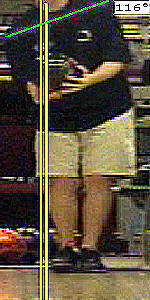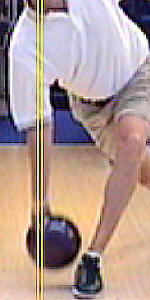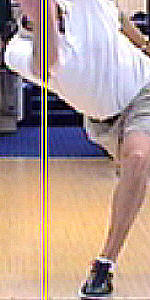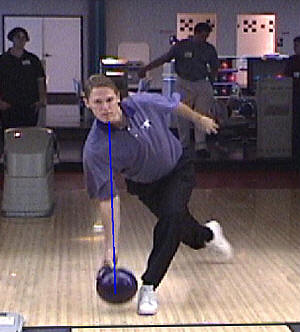|
What is The Swing Plane About
One of the most
common areas of concern is how to develop
consistency and accuracy in your
bowling. Having a goal to developing these
skills is key toward enhancing
your ability to score well and raise your average.
It is not uncommon to focus on all
sorts of adjusting, changing balls and becoming
frustrated, only to learn the better solution is to
fix the root problem. You cannot be accurate
until you develop consistency. The willingness
to be objective and focused if you are to achieve
both consistency and accuracy. First
learn the trade, and then learn the tricks of trade.
Accuracy is a byproduct of
consistency. When the swing of your ball moves
in different direction from swing to swing, or you
attempt to guide the path of your ball toward your
target with your arm swing, that inconsistency
creates different ball paths, and results in
different outcomes for each shot. This fact
makes it much more difficult to be accurate. A
more satisfying approach is to swing the ball in a
straight line, or within a small area called a swing
slot or swing plane.
What is the Swing Plane
The swing plane is the route your ball
takes as it travels from the initial point of movement through the
release point and follow-through.
The Swing Plane is a virtual narrow box vertically
inline with the ball and perpendicular with the
lane.
Keeping the swing plane fresh in your mind promotes
increased accuracy and body fluidity in your
approach.
In its simplest essence, the swing
plane defines the shape of your swing. When
you watch bowlers more carefully, you quickly learn
that the shape of most swings are unique. Most bowlers have
their unique swing path.
The Swing Plane
in a nutshell
When you watch top level athletes,
you can see their swing plane, or as some call it,
their swing slot. This technique is key and
one of the most important factors that
differentiates great bowlers from the rest of the
field.
Advanced players in active sports
using the swing of a bowling ball, a club in golf, a
baseball, basketball, or football
have a great swing. They target with their
eyes. They keep their golf club, baseball bat,
basketball, or bowling ball
directly in line with their eye. And they also
keep their eye in line with their target throughout the
swing. These three components form a straight
line: object, eye and target.
You can see this technique as a
basketball player shoots their foul shot with their
eye directly behind their ball, or as a golfer
swings their club and their eye is directly in line
with their ball and their target. The line
formed by these two points is extended toward their
target. You see this technique in advanced
bowlers as well.
What Are Our Goals
Create a consistent swing. If
we cannot repeat the swing of our ball, we cannot
achieve accuracy.
Hit our target consistently. Since
the path of the bowling ball is most often not a
straight line, we still have targets, and need to
reach our target accurately ball after ball.
The vast majority of advanced bowlers have a
pronounced lower throwing shoulder. Also,
their 2nd to the last step of their approach is in
front of their sliding foot. These two
characteristics of those who excel in their sport
are key to accurate and consistent scoring.
Keeping your aim in line with the ball swing.
When the ball is allowed to travel along a
straight swing line, it should be apparent that
enhanced accuracy will result more than would a ball
that travels along a wide swing plane. The
dominant eye should remain directly in line with the
ball, shoulder and target. When performing
your delivery, you stand a better chance of staying
on-line with your target when your eye, shoulder and
ball are all in alignment.
As to the initial pushaway of the ball into this
narrow swing plane, if the swing is to remain free
from arm muscle movement that may influence the ball
path away from that alignment, the body must remain
clear of the ball swing. At the end of the
pushaway, the ball must be allowed to free fall into
the backswing after the first step of a four-step
approach or second step in a five-step approach.
The bowler's ball-side foot, then, must move away
from that free swinging ball. The ball-side
foot is placed in line with the sliding foot as if
the bowler were walking a tight rope.
Inconsistent Ball
Swing
There are a wide
variety of ball swings that loop toward the ball
channel either to the front or rear of the bowler at
the beginning of the ball movement. While
these methodologies have merit for the advanced
bowler, it is best to establish solid, narrow
ball swing that results in accurate and consistent
bowling. Most often, a wide ball swing plane
results in an inconsistent result.
Ultimately, the goal of
developing a clean, narrow, well defined swing plane, increase the
bowler's ability to
repeat good shots and improve accuracy.
|
 It Starts In The Stance It Starts In The Stance
More advanced bowlers drop
(lean) their ball-side shoulder down to
align their eye over the ball.
From the stance, through the swing and
ultimately the release of the ball, the head
remains over the ball. Since
you eyes are focused (You are focused aren't
you?) on your target, this three-point
alignment creates our starting point of your
ball swing. You are able to do this
consistently. It is a great place to
begin an ideal swing.
 Maintaining
a Tight Swing Plane Maintaining
a Tight Swing Plane
As the ball is extended
toward the target into the pushaway, the
head remains over the ball. If you are
to maintain a straight swing, your body
needs to move out of the way of the swing.
This occurs by combining the initial lean of
the ball-side shoulder paired with your foot
movement.
The second step of a 5-step
or the first of a 4-step delivery is placed
directly in front of the sliding foot, as
though you were walking a balance beam.
This keeps the ball swing straight in line,
and keeps the ball swing under the head.
Once you develop this technique, your ball
swing is started on a consistent, accurate
swing path.
 Swing
of the Ball Free and In Line Swing
of the Ball Free and In Line
As the ball freely swings back,
the ball remains in the swing plane, and upward into
the back swing. The wider the swing plane, the
more accuracy is affected. Tighter is better.
The ball swing should remain free and the arm
without tension. As the ball swings
downward toward the release point, the shoulder
remains dropped, and the head remains over and in
line with the ball swing and target. This
allows the ball to remain within the swing plane
into the release point.
 The
Release and Follow Through The
Release and Follow Through
The release and follow through, the head,
ball and target remain in line, and the head
and ball remains within the swing plane to
avoid altering the ball path.
At the release, right handed bowlers will be
seen with their head in the 1 O'clock position, and
their trailing leg at 7 O'clock.
head in the 1 O'clock position, and
their trailing leg at 7 O'clock.
Left handers will end with their head in the
11 O'clock position and their trailing leg
at 5 O'clock position.
Your approach should be in a consistent,
straight line as though you were walking
a balance beam. The best swing path is
the one that best works for you, but must
result in a consistent and accurate path.
If you take any steps out of line while your
ball is swinging, it will alter the swing path.
Holding the ball in your non-ball side
hand during the stance, and maintaining
consistent gripping pressure on the ball
enhance a straight ball swing. Changes
in the tension in your arm or gripping
pressure changes the swing path.
Developing a free arm swing, and avoiding
the urge to guide the ball are key
factors in achieving accuracy. Again,
changes in the tension in your arm changes
the swing path.
The non-bowling arm swing is meant to maintain body balance. What you do with your
non-bowling arm affects body balance and the swing path.
Keeping the swing plane tight
involves starting in the stance with the
ball-side arm positioned comfortably down at
the side, with the horizontal ball position
midway between the shoulder and the middle
of the chest. This places the ball
near the center of the stronger body
muscles, and minimizes body tension.
Avoid stress on the arm or shoulder by placing the ball too
far inside or outside the major strength
muscles since that causes stress on the arm,
shoulder and back. If the ball
is held too far inside or outside during the
stance, the swing path of the ball is
altered, and requires muscle tension to
bring it back into the intended swing plane.
 Swing the ball close to the ankle at the point of
release for consistency and maximum leverage. Swing the ball close to the ankle at the point of
release for consistency and maximum leverage.
Develop Good Timing.
Early or
late or timing alters your ball swing path
by causing you to release the ball early or
pull the ball through; either timing alters
your ball path.
Many variables affect the ball swing path.
It is evident that having a perfectly
straight ball swing would be very difficult,
but in essence, the tighter the ball swing
plane, the more consistently accurate you
will be.
|